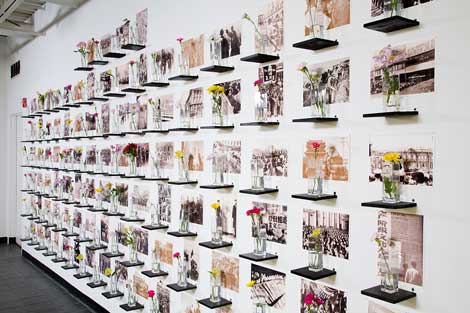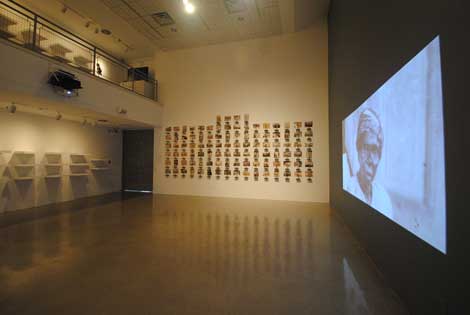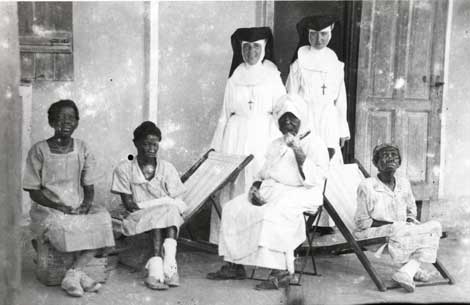Pitzer College’s exhibition, “Racial Imaginary,” the visual art component of a larger project that includes a book of essays, musings and poems, demonstrates the fecundity of race and identity for artists of all media and aesthetic proclivities. The featured artists primarily working in video, sculpture and photography, engage with the question of what it means to create race-based art in an era in which racial divisions are simultaneously dismissed as archaic but are more entrenched than ever.
The main room of the gallery contains two of the most memorable pieces on display—Edgar Endress’ Acts of Erasure no. 2 and Dread Scott’s Let 100 Flowers Bloom, Let 100 Schools of Thought Contend. Endress’ short video, set to quietly throbbing music, features two early 20th-century photographs taken in quick succession of four African American patients and two white nuns at a leprosarium in the Virgin Islands. Endress erases the nuns from the second photo, cutting back and forth from the photo where they exist, looming over their charges, to one in which they are elided. Endress reverses the centuries-long trend of rendering black men and women invisible, and here has them remain stolidly and stubbornly present. Scott’s piece is a grid of black-and-white photographs affixed to the wall, each with a small black shelf and a clear vase with a white flower perched in front of it. The photographs are primarily images of the Soviet and Chinese Communist eras, ranging from peaceful scenes of peasants tilling fields, people playing instruments and Mao solemnly looking out over a crowd to images of children wielding wooden guns, people running through the street in terror and women in breadlines. The contrasts between rhetoric and reality are stark with Scott keen to remind viewers of the dangers of mass-based identity and blind adherence to cultural dictates.

Dread Scott, Let 100 Flowers Blossom, Let 100 Schools of Thought Contend (2007/2014), Inkjet prints, wood, flowers, Courtesy of the artist.
Todd Gray takes on the theme of identity as well, taking a close-up photo of his head and neck effaced by viscous white shaving cream. Part of his “Shaman” series, the artist’s dark hair and boldly staring eye peer out of the cream suggests a magnetic, mystical power beneath the mask. He is a modern Invisible Man, but one who refuses to stay wholly hidden. A video piece by his wife, Kyungmi Shin, is exhibited nearby. Titled Blue Eyes Series, the work is a looped projection of photographs of men and women of various ages and races, digitally altered so they all have brilliant, icy blue eyes. The effect is both beguiling and disturbing, conjuring Toni Morrison’s The Bluest Eye and suggesting how standards of beauty are still based on the Anglo-Saxon heritage.

Installation view of Racial Imaginary at Nichols Gallery, Pitzer College Art Galleries,
Courtesy of Pitzer College Art Galleries
Other artists in the show make more explicit commentaries on lived experience. EJ Hill’s video Crawl for Your Life shows a black man crawling across a field. Curious spectators stare, but he steadfastly inches his way from one side of the field to another. Charles McGill’s ObamaNation is an empty golf bag plastered with The New York Times headlines from Barack Obama’s inauguration and other scenes from black history: Sambo, minstrel shows, Malcolm X, covers of Ebony. The piece asks viewers to consider Obama’s place in the narrative of racial progress—is he its apotheosis or an aberration? Did his election really augur a post-racial world?
There are a few musings on gender: Alice Shaw’s four sets of paired photographs, one of a white woman and one of a black woman (who, as the last set reveals, is actually transgendered), exploring the racial and gendered conventions of photography, and Liz Cohen’s video Hydro Force, an amusing send-up of the conflation of cars and sex achieved through the artist, heavily pregnant and in a bikini and stilettos, posing in and next to a hydraulic classic car.

Installation view of Racial Imaginary at Nichols Gallery, Pitzer College Art Galleries,
Courtesy of Pitzer College Art Galleries
“Racial Imaginary” explore the constructs of race and gender in contemporary America, identifying the ways in which they are both entrenched and fungible. A pair of blue eyes can obscure racial identity, but progress might be made at the pace of a crawl rather than a walk.
“Racial Imaginary” at Nichols Gallery,
Pitzer College Art Galleries,
September 20 – December 5, 2014




